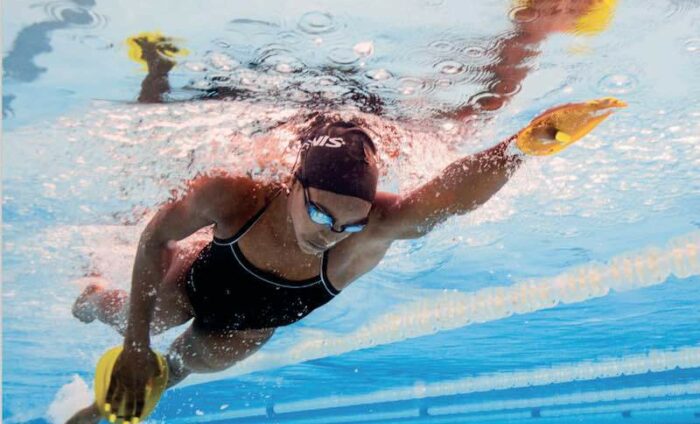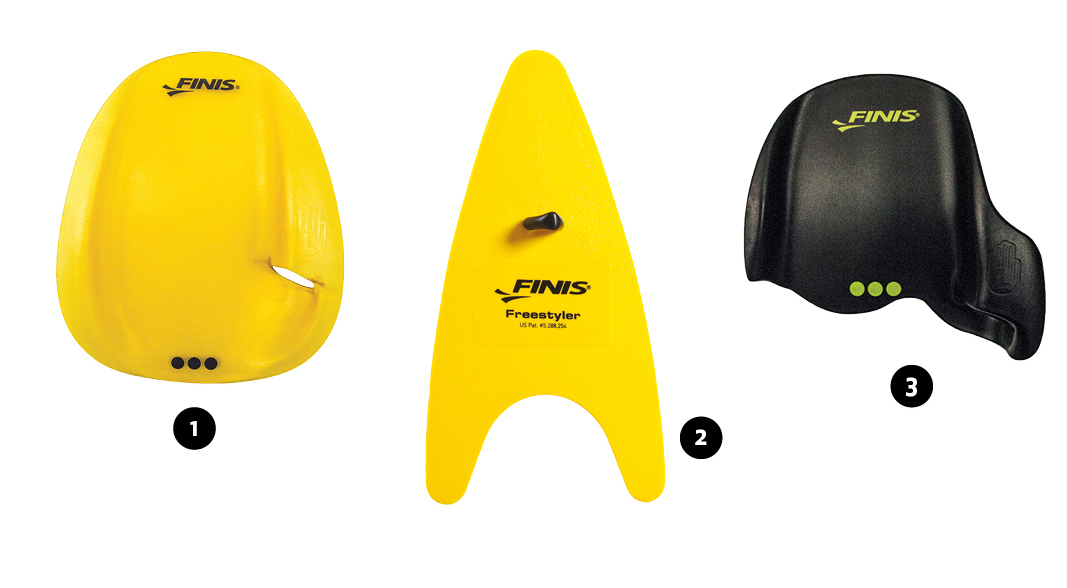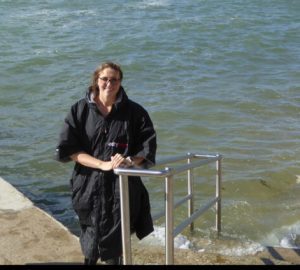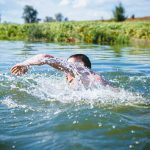
Fine tune your catch
Fiona Ford explains how to use paddles to perfect your catch
As a coach, one of the most common issues I see when analysing swim videos is a tendency for swimmers to press down or introduce lateral movement with the hand, instead of catching the water efficiently. This flaw seriously harms the pull phase and forward propulsion. Pressing down instead of back causes lift at the front of the stroke and often compounds existing drag issues from the hips and legs while lateral hand movements can induce ‘snaking’ and increase drag.
The judicious use of paddles can help both the swimmer and coach identify and correct these technique flaws. Note that we are not talking about using paddle work for building strength and power. Instead, the use of paddles should be specific and targeted to the swimmer’s stroke technique requirements. If the catch and pull mechanics are optimal then functional training of the back and lats will be achieved alongside refining technique. However, if the hand is too high in the catch or the stroke is too long due to pausing and gliding or over-reaching then there is a risk of shoulder injury using paddles. Paddles may also encourage ‘pressing’ if the catch mechanics are misunderstood and this will feel like a ‘good catch’ to a swimmer with poor feel for the water.
As working with paddles does pose an injury risk I recommend that you consider first having your underwater stroke mechanics video analysed to observe the catch and pull phases and identify specific areas that require correction. Paddles should always be used with caution and removed if they cause any discomfort or pain.
The training session in this issue will help you work through a process of identifying and tuning up your catch and pull using paddles and drill work to apply into your freestyle stroke, using your perception and observation skills! There are two versions: a full distance one that should take between one and two hours depending on your speed and a short version that you can cram into your lunchbreak if time is short.
Session 1 – Catch & pull diagnosis and tune up
Warm Up
– 400m FS. While swimming, observe and note the depth of catch after hand entry on each stroke.
– 300m PULL. Now observe the degree of elbow bend on left and right arms as each travels below your shoulders and body.
– 200m doggy paddle with fins or pull buoy. Observe the transition from catch into pull. Does the arm move as one continuous limb from hand to shoulder (i.e. like a pole) or does the elbow remain forward as the forearm swings down (arm movement in two parts)?
– 100m FS. Build pace from 60 to 90% and note speed and effort level where your catch & pull feels together and consolidated.
– Take 30s rest after each.
Main set
– 400m with paddles (fins optional) alternating ‘kick-on-side’ drill and freestyle each length. On the drill, keep your leading hand slightly flexed with your palm consistently facing the bottom of the pool when kicking on your side, breathing in or breathing out and looking down. Apply a deliberate (but subtle) flex of your wrist as your hand reaches 20-30cm below the surface. Compare to the catch position and depth you observed during the warm up. Use Finis Freestyler paddles or standard hand paddles with only the middle finger in the loop (not all straps) to gain feedback on hand movement via wrist flexion or lateral movement on breathing.
– 400m FS negative split (no paddles). Work on applying an effective catch technique (flex your wrist slightly after hand entry) and remain at effort level where your technique feels consolidated.
– 2 x 200m (+30 sec rest) alternating single arm drill into FS each length. Use small sculling or finger paddles or FINIS Agility paddles and work on a bent elbow pull with hand travelling below the shoulder as you finish your pull phase towards your thighs. Aim to maintain the elbow high and forward as the forearm approaches vertical, observe this as the arm passes the head.
– 2 x 200m FS at CSS pace + 30 sec rest. Maintain effective pull technique and note impact on times and perceived effort.
– 4x100m as pull & paddles. Consolidate catch and pull by observing the elements above.
– 4 to 8 x 50m FS at aerobic pace (no paddles). Consolidate and correct technique in FS from paddle swimming feedback. Note any impact on times.
– Take 30s rest after each.
Cool down
– 200m easy
– Total distance: 3600m
Session 2 – Lunchtime special (the short & sweet 30-minute version)
Warm up
– 100m FS. While swimming, observe and note the depth of catch after hand entry on each stroke.
– 100m PULL. Now observe the degree of elbow bend on left and right arms as each travels below your shoulders and body.
– 100m doggy paddle with fins or pull buoy. Observe the transition from catch into pull. Does the arm move as one continuous limb from hand to shoulder (i.e. like a pole) or does the elbow remain forward as the forearm swings down (arm movement in two parts)?
– 100m FS. Build pace from 60 to 90% and note speed and effort level where your catch & pull feels together and consolidated.
– Take 30s rest after each.
Main set
– 200m with paddles (fins optional). Alternate kick on side drill and freestyle each length (see above for details on drill and paddles).
– 200m FS negative split effort (no paddles). Work on applying an effective catch technique (flex your wrist slightly after hand entry) and remain at effort level where your technique feels consolidated.
– 200m alternating single arm drill and FS each length. Use sculling, finger or Agility paddles. Work on vertical forearm in pull phase.
– 200m FS at CSS pace. Maintain effective pull technique and note impact on times and perceived effort.
– 4x50m as pull & paddles. Consolidate catch and pull by observing the elements above.
– 4x50m FS at aerobic pace (no paddles). Consolidate and correct technique in FS from paddle swimming feedback. Note any impact on times.
– Take 30s rest after each.
Cool down
– 200m easy
– Total distance: 1800m
GUIDANCE NOTES
FS = Freestyle
CSS pace = Critical Swim Speed. A swimmer’s sustainable threshold pace, not all out sprint.
Aerobic pace = CSS +3-5 sec per 100m
PULL = Swimming with a pullbuoy or float
Negative split = Swim second half of the swim faster than the first between your legs. No kicking.
PADDLE TYPES

I recommend my swimmers use the following types of paddles:
1) FINIS Agility
These strapless paddles just have a thumb hole to keep them in place and rely on you having a good catch to stay on the hand due to water pressure. They also provide feedback on any lateral movement of hand and help you engage your forearm for the pull.
2) FINIS Freestyler
These are the long triangular shaped paddles with pointy ends and a ‘keel’ on the bottom. Use only the middle finger strap to hold in place and don’t curl your fingers around the edges. These provide feedback on alignment issues such as thumb first entry or hand in front of head. They also assist with good catch mechanics due to their shape.
3) Sculling or finger paddles
These are the small, half-moon shaped paddles (available from several brands). Fit over the fingers only. These are effective paddles to help train catch initiation.
SWIM SMOOTH SQUAD TRAINING AND ViIDEO ANALYSIS SESSIONS
Triathlon Europe provides weekly Swim Smooth squad training in South West London. The squad enjoy training all year round in fabulous indoor and outdoor 33m pools. Fiona offers swim training plans, 1-2-1 video analysis sessions and stroke correction sessions on weekday mornings and weekend Swim Smooth workshops.
Find out more: triathloneurope.com








